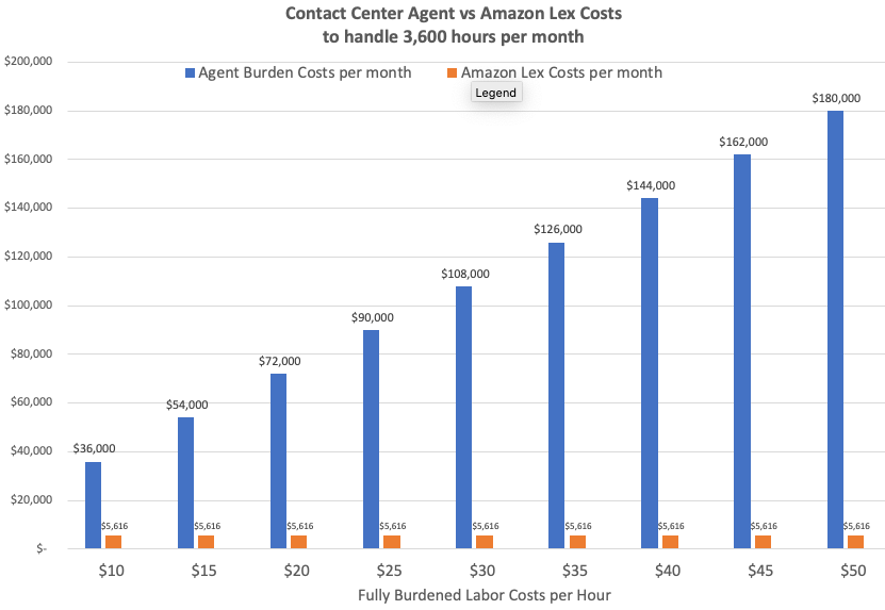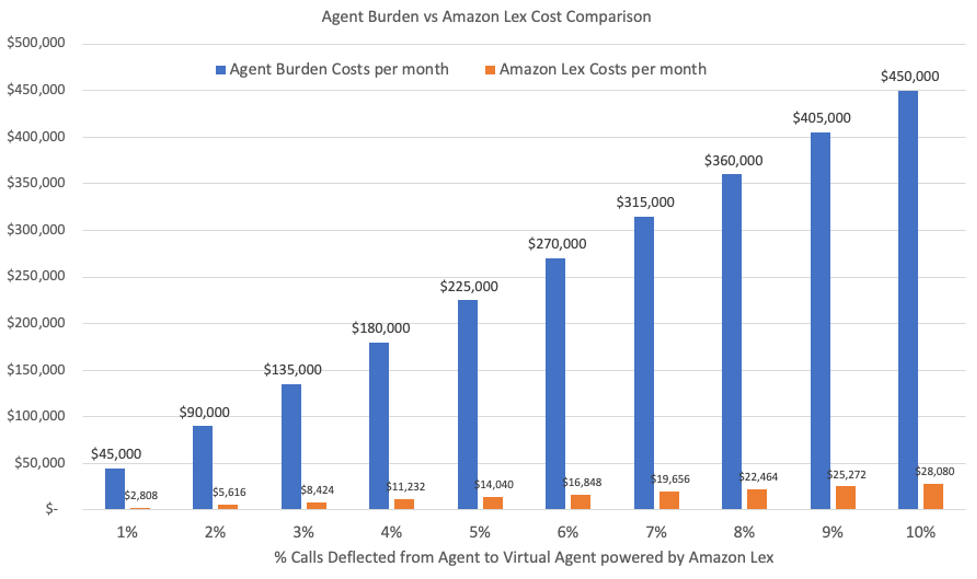AWS for Industries
Improving Customer Experience and Delivering 94% Savings Using Amazon Lex
Introduction
All contact centers face a difficult balancing act between customer wait time and agent staffing. If not done right, contact centers might either staff too many agents, thus increasing operating costs, or too few agents, thus increasing customer wait time. This increased wait time translates to poor customer experience and even lost customers. What if you don’t have to sacrifice customer experience while reducing agent burden and thus operating costs at the same time? In other words, can you have your cake and eat it too? Yes, you can!
This blog will illustrate this with a hypothetical customer example where you will see not just a better customer experience but also a 94 percent cost savings worth more than $3 million in 3 years.
A better customer experience
Every travel and hospitality (T&H) enterprise wants to deliver a differentiated customer experience for their travelers and guests.
Let’s consider, for example, a car rental organization. Assume that they have 1,500 contact center agents who talk with their customers for an average of 6 hours a day, 20 days a month, thus amounting to 10.8 million minutes per month.
Let’s assume that 2 percent of the customer calls fall under the category of frequently asked questions (FAQ) such as the following:
- “I need my rental receipt.”
- “My flight was delayed, and I just arrived. It’s 1:00 a.m. Where is my car?”
- “How much time should I plan for to go from your rental center to the airport?”
- “I don’t have time to fill up the gas tank. Will I be charged?”
- “I need to stay for 2 more days. How much will it cost me?”
- “How much does a car seat cost?”
A live agent doesn’t need to address such FAQ. Advanced artificial intelligence (AI) and machine learning–driven conversational chatbots (virtual agents) can automatically answer such FAQ in real time, without any customer wait time, thus improving the customer experience significantly. Such virtual agents can communicate through multiple channels like voice, SMS, web chat, and WhatsApp and even simultaneously across channels. For example, when a customer of the car rental company asks for the latest travel receipt, the virtual agent has the flexibility to send it to an email address or phone number through a text message while continuing to serve the customer over voice for other questions.
A reduction in operating costs
Deflecting 2 percent of the calls to an automated chatbot also delivers 97 percent operating cost savings as explained below.
A meager 2 percent of 10.8 million minutes per month of call deflection to a chatbot translates to 216,000 minutes or 3,600 hours. The benefit for the contact center is that it reduces the total agent burden by 3,600 hours per month. This gives agents the ability to spend more time on more important questions, thus improving their productivity. Assuming a very nominal $25 per hour fully burdened (salary, bonus, overtime, benefits) labor cost, 3,600 hours per month translates to $90,000 in savings per month. This means savings of $1.08 million per year or $3.24 million in 3 years.
Of course, we need to factor the technology costs to deliver the chatbot to calculate net savings. Amazon Web Services (AWS) offers Amazon Lex, a fully managed AI service with advanced natural language models to design, build, test, and deploy conversational chatbots.
Let’s calculate Amazon Lex costs to determine net savings. As of January 2022, the streaming conversation cost for Amazon Lex is priced at $0.0065* per 15-second speech interval (more details here). Thus, total Amazon Lex costs are (3,600 hours x 60 minutes / 15-second interval) x $0.0065 per 15-second interval = $5,600 per month = $67,300 per year = $202,000 in 3 years.
Thus, by handling just 2 percent of the 10.8 million calls per month using an Amazon Lex voice chatbot, the customer gains a net savings of $3 million in 3 years, or 94 percent of the total planned savings by diverting those calls, in addition to an improved customer experience. Also, note that savings would be even higher if the customer were to use the Amazon Lex text chatbot instead of the voice chatbot as Amazon Lex text request pricing is relatively lower than voice pricing*.
*The price does not include taxes, could vary by AWS Region, and is accurate as of January 26, 2022. Please check here for the latest pricing.
Agent burden versus Amazon Lex voice chatbot cost comparison
Different organizations will have different fully burdened agent costs. The following graph shows a comparison of agent burden costs versus Amazon Lex costs per month for varying scenarios of fully burdened agent labor costs per hour.
The percentage volume of calls that are FAQ might vary for each customer. The following graph shows a comparison of agent burden costs versus Amazon Lex costs per month for different percentages of calls with FAQ deflected to virtual agents, assuming $25 per hour fully burdened labor costs.
As you can see from the graph above, the total cost savings increase dramatically as a greater percentage of calls are deflected to virtual agents powered by Amazon Lex.
Key use cases
Thousands of organizations have modernized their contact centers using Amazon Connect, an easy-to-use omnichannel cloud contact center (customer case studies here). They have used Amazon Lex alongside Amazon Connect to create virtual agents that automatically help resolve customer questions or guide customers to the right agent.
Some organizations who use other contact center solutions such as Genesys PureCloud have also used Amazon Lex to deliver virtual agents and a better customer experience. For more details, check out this blog. Customers with any contact center can deflect high-volume, low-value calls to a voice/text bot powered by Amazon Lex by using Amazon Lex APIs and reduce contact center agent burden.
Many organizations have created informational bots in their websites and mobile apps for everyday requests and FAQ.
Some organizations, like Hawaiian Airlines, have also created application bots for internal enterprise use cases to improve productivity by automating many mundane user tasks.
Benefits for T&H enterprises
There are clear benefits for T&H companies to adopt conversational AI solutions:
- Airlines like Delta have modernized their contact centers using Amazon Connect. They can divert many of their contact center calls to voice/text bots for FAQ such as tracking baggage or answering COVID-19 pandemic–related or preflight queries.
- Hotels like Marriott and Wynn Las Vegas have simplified guest access to amenities using Alexa for Business, a service that empowers organizations and employees to use Alexa to get more work done. Note that Amazon Lex is powered by the same conversational engine as Alexa.
- Car rental companies like Avis Budget Group have automated and simplified rental reservations, streamlined roadside support, and answer billing inquiries using Alexa for Business.
- Restaurants are using chatbots to check hours of operations, review menus, automate and update ordering, verify deliveries, and more. For example, Le Rivage, a traditional French cuisine restaurant in New York City, used a chatbot to streamline staff time for order taking by 50 percent.
Using Amazon Lex, T&H enterprises can modernize internal support to various lines of businesses and support to various franchises.
Recent examples of these enterprises include the following:
- RedAwning has more than 140,000 properties in more than 10,000 destinations—all instantly bookable. “Using Amazon Connect with Amazon Lex, it was easy to build an intelligent virtual agent to answer calls, match guests with their reservations, and engage naturally with users,” says Tim Choate, founder and CEO of RedAwning.
- Ryanair is one of Europe’s largest airline groups, flying more than 150 million passengers per year to more than 200 destinations on 2,400 daily flights. The company worked with Cation Consulting, an AWS Partner, to deliver its solution. Using Amazon Lex and Amazon SageMaker, which lets users build, train, and deploy machine learning models for virtually any use case, Ryanair built a chatbot that improves its customer support experience and helps customers find answers to their questions quickly and simply.
Many other customers have used Amazon Lex to deliver natural conversations with their customers in multiple languages through multiple channels, sometimes concurrently. You can find a full list of customer case studies here.
AWS Partners that can help
At re:Invent 2021, AWS launched the new service Amazon Lex automated chatbot designer, which helps developers automatically design chatbots from conversation transcripts in hours rather than weeks. Amazon Lex helps to build, test, and deploy chatbots and virtual assistants on contact center services (such as Amazon Connect), websites, and messaging channels (such as Facebook Messenger). This automatic chatbot designer enhances the usability of Amazon Lex by automating conversational design, minimizing developer effort, and reducing the time it takes to design a chatbot.
However, if you are more of a “buyer” than a “builder,” AWS has experienced AWS Partners in this space. Here are a few examples below:
- NLX offers a comprehensive, low-code approach to transform customer interactions into automated, personalized self-service experiences for zero setup cost and a pay-per-use pricing model. Check out how Copa Airlines and Le Rivage restaurant benefited by using NLX’s technology powered by Amazon Lex, or try it for yourself here. Find NLX on AWS marketplace!
- VoiceFoundry helped Deliveroo support customers in dozens of languages.
- Quantiphi explains their solution in this blog: Redefine CX for Travel and Hospitality Industry with AI-Powered Virtual Agent
- XAPP AI has created a conversational self-service bot using Amazon Lex and other AWS services.
- Many other AWS Partners offer solutions using Amazon Lex such as Cation Consulting, Concentrix, Deloitte, PolyAI, ServisBOT, and TensorIoT.
Conclusion
Customer experience matters. And organizations can improve customer experience while reducing agent burden costs by augmenting their existing legacy contact centers or even those using Amazon Connect with a fully managed AI service with advanced natural language models using Amazon Lex. Click here to learn how other customers have benefited by using Amazon Lex. Also, please reach out to your AWS account team or any of the AWS Partners mentioned above to accelerate your journey to voice/text chatbot virtual agents powered by Amazon Lex.
To learn more about how travel and hospitality companies are building what’s next on AWS, check aws.com/travel.

